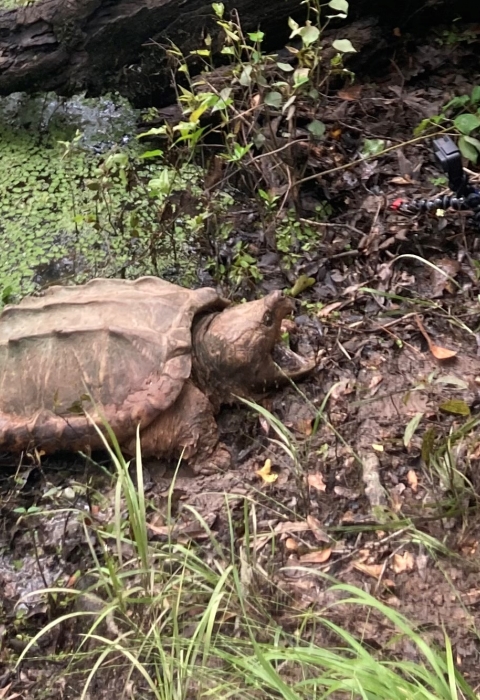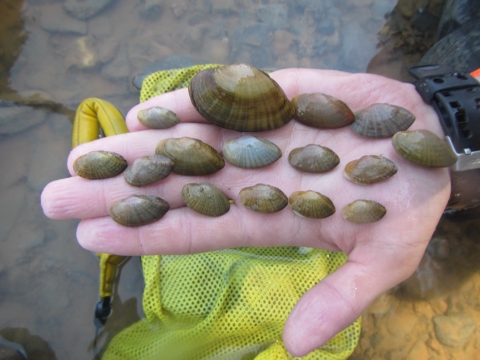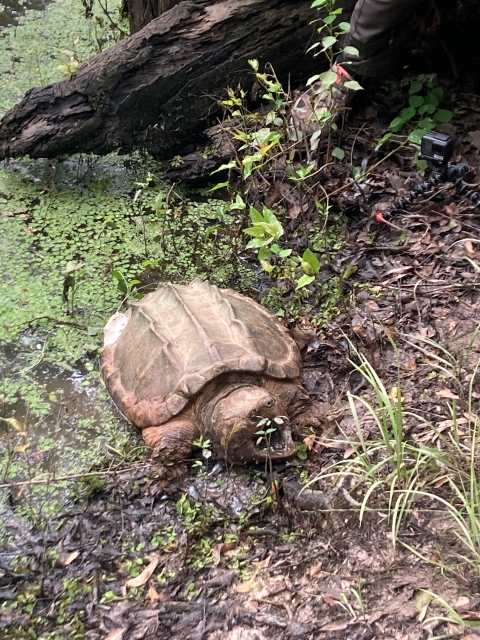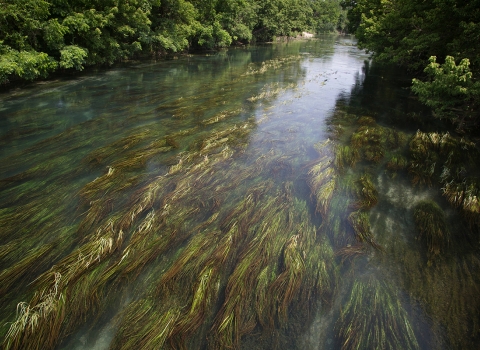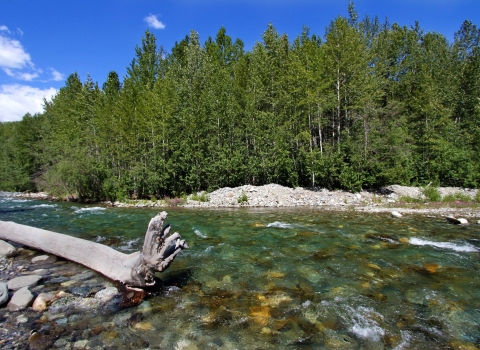The U.S. Fish and Wildlife Service (Service) seeks public comment for a proposed Candidate Conservation Agreement with Assurances (CCAA) for six aquatic species in the Trinity River basin. The 10-year agreement with the Trinity River Authority of Texas would address the conservation needs of four species of freshwater mussels (Texas heelsplitter, Trinity pigtoe, Texas fawnsfoot and Louisiana pigtoe), and two species of turtles (western chicken turtle and alligator snapping turtle).
“This collaborative conservation agreement will help the Trinity River Authority meet the water needs of a growing human population while preserving habitat and maintaining water conditions for fish and wildlife that depend on the Trinity River,” said the Service’s Southwest Regional Director Amy Lueders. “We encourage the public to review the draft agreement and provide us with their input during the public comment period.”
A CCAA is a formal, voluntary agreement between the Service and non-federal landowners to conserve habitat that benefits at-risk species. In return, participants receive assurances that no additional conservation measures will be required if a species covered by the agreement becomes listed in the future as threatened or endangered under the Endangered Species Act (ESA).
The Service provides these assurances through an “enhancement of survival” permit, giving authorization to participating landowners for take (of listed species) that is incidental to conservation and ongoing activities covered by the CCAA. Take includes harming or killing a listed species and is prohibited under the ESA unless a permit is issued.
The Texas heelsplitter, Trinity pigtoe, Texas fawnsfoot and Louisiana pigtoe are freshwater mussels whose historical ranges include various portions of the Trinity River basin from its headwaters to the Gulf of Mexico. Threats to freshwater mussels include habitat loss, degraded water quality, increased sedimentation, and changes to the flows of rivers and streams due to diversions and development. The Texas fawnsfoot was proposed for listing as threatened under the ESA in 2021, while the Texas heelsplitter was proposed for listing as endangered and the Louisiana pigtoe as threatened under the ESA on March 20, 2023. The Trinity pigtoe is not currently under review for listing under the ESA.
The western chicken turtle and alligator snapping turtle are freshwater turtle species that are in decline throughout their historical and current range, including in the Trinity River basin. Both can be found on land but mainly inhabit aquatic environments. The alligator snapping turtle frequents ponds, lakes and large rivers, while the western chicken turtle prefers slower-moving backwater areas, swamps, and ephemeral ponds. Threats to freshwater turtles include habitat loss, habitat degradation, fishing by-catch and poaching. The alligator snapping turtle was proposed for listing as threatened under the ESA in 2021, while the western chicken is currently under review for potential federal endangered species protection.
Conservation measures outlined for these species in the CCAA include protection of environmental flows to support a sound ecological environment; avoidance and minimization measures, applied research to better understand the lifecycle, tolerances and habitat preferences of these species; the creation of conservation zones to prioritize conservation projects; public outreach efforts; and implementing long-term monitoring to track the status of the species in the Trinity River basin.
Healthy aquatic systems are important for fish, waterfowl, other wildlife as well as human communities, businesses, and economic enterprises. Efforts and actions to improve the water quality and natural hydrology (flows) of rivers and streams that freshwater mussels and turtles depend upon, will also benefit the human communities and businesses dependent on these water sources.
One of the Service’s priorities is to make implementation of the ESA less complex, less contentious and more effective. We seek to accelerate recovery of threatened and endangered species across the nation, while making it easier for people to coexist with these species. In addition to the Trinity River Authority and the Brazos River Authority, which finalized a similar agreement last year, the Service has been working with several other Texas river authorities to develop CCAAs to benefit at-risk and imperiled species in Texas.
Research focused on helping improve the understanding of the species has been funded by the Office of the Texas Comptroller, Texas Parks and Wildlife Department, the Service, and others.
The Service encourages the public to review and provide comments on the documents during the 30-day public comment period. Information on how to obtain or review copies of these documents, or how to provide comments can be found here.
Q. What action is the U.S. Fish and Wildlife Service proposing?
A. The U.S. Fish and Wildlife Service (Service) is announcing the availability of an enhancement of survival (EOS) permit application from the Trinity River Authority (TRA) for six aquatic species. The application includes a Candidate Conservation Agreement with Assurances (CCAA) that allows for species conservation with continued water supply, water treatment, and wastewater discharge operations to continue in the Trinity River basin in Texas.
If approved, the CCAA and associated EOS permit would be in effect for 10 years and would authorize incidental take of four species of freshwater mussels (Texas heelsplitter, Trinity pigtoe, Texas fawnsfoot and Louisiana pigtoe), and two species of turtles (western chicken turtle and alligator snapping turtle). The proposed incidental take would result from activities associated with otherwise lawful activities, including implementation of the conservation strategy and conservation measures, as well as ongoing and continuing water supply and wastewater treatment activities.
Q. What is a Candidate Conservation Agreement with Assurances (CCAAs)?
A. CCAAs are voluntary agreements that provide non-federal landowners, industry, local government and others the opportunity to implement conservation practices that address specific threats to at-risk species with assurances that, if the species is listed, they can continue to manage their land and water resources as outlined in their agreements with no additional requirements. If a species is listed and a CCAA is in place, those entities enrolled in the CCAA will not be required to do more than they have agreed to do under the agreements.
Q: Which species are included in the agreement?
A: The Texas heelsplitter was proposed for listing as endangered under the ESA on March 20, 2023. It is an elliptical shaped mussel with adults reaching up to 177 mm in length. It prefers slow to moderately flowing habitats in deep pools with sand or mud substrate, although recent research has suggested that they prefer bank habitats. This species is capable of surviving in backwater and reservoir habitats.
The Trinity pigtoe is not currently under review by the Service for potential listing under the ESA. It was recently distinguished as genetically separate from other pigtoe species present in Texas and has a distribution restricted to the Trinity basin, specifically in the mainstem of the Trinity River near Dallas-Fort Worth to just above Lake Livingston and adjacent tributaries.
The Texas fawnsfoot was proposed for listing as threatened under the ESA in 2021. It is a rare, elongate oval shaped mussel with adults reaching up to 60 mm in length. It was thought to be endemic to the Brazos and Colorado river basins, though they historically occurred in the Trinity River basin. It is known to bury in up to 15-20 cm of sand, or in a mixture of sand and gravel, near the shore in riffles.
The Louisiana pigtoe was proposed for listing as threatened under the ESA on March 20, 2023. It is a triangular shaped mussel with adult shell length over 62mm. The species is thought to be extirpated from the Trinity River basin.
The western chicken turtle is currently under review for an ESA listing. It is a small to medium-sized freshwater turtle that is easily identified by its extraordinarily long, striped neck. The species is considered rare and declining throughout its range, although no range-wide population surveys have been conducted. In Texas, the historical range once comprised the entire eastern third of the state.
The alligator snapping turtle was proposed for listing as threatened under the ESA in 2021. It has a characteristic spiked shell and large, broad head. Adult males can reach 175lbs or more with females weighing around 50 lbs. The species is known to have a lifespan over 100 years. They can be found on land but mainly inhabit aquatic environments, preferring the calm deep waters of ponds, oxbows, lakes, and large rivers.
Q. How would the CCAA benefit these species?
A. CCAAs are intended to reduce or remove identified threats to a species. Conservation measures outlined for the six aquatic species in the CCAA include protection of environmental flows to support a sound ecological environment; avoidance and minimization measures; applied research to better understand the lifecycle, tolerances and habitat preferences of these species; the creation of conservation zones to prioritize conservation projects; public outreach efforts; and implementing long-term monitoring to track the status of the species in the Trinity River basin.
While the conservation measures outlined in this document are designed to benefit these six species specifically, they should also benefit other aquatic species, including amphibians, fish, and macroinvertebrates.
Q. If the draft CCAA is approved, will it preclude the need to list the species?
A. CCAAs are effective because they encourage voluntary participation from users of the land whose operations could be affected if one or more of these species were to be listed for protection under the ESA. The idea is that if sufficient conservation measures are being implemented prior to a listing, increased regulation for protecting the species might be unnecessary. The most significant benefit of the CCAA is that they will guide conservation actions that improve the status of these species and their habitat within the Trinity River basin. However, the Service can in no way guarantee that participation in these agreements will prevent the listing of any species.
Q. Why are freshwater mussels and turtles important?
A. There are approximately 300 species of freshwater mussels in North America and many species are in decline. Currently, 38 mussel species are extinct and 77 are considered impaired. Mussels are biological indicators of healthy streams and rivers that benefit people and wildlife. The presence of diverse and reproducing mussel populations indicates healthy ecosystems, good fishing, and high-quality water conditions for waterfowl and other wildlife species. It also provides assurances that our water is safe.
Mussels perform important ecological functions. They are natural filters, and by feeding on algae, plankton, and suspended detritus and silts, they help purify the aquatic system. Mussels are also an important food source for many species of wildlife including otters, raccoons, muskrats, herons, egrets, and some fish.
The U.S. encompasses a globally significant biodiversity of wild turtles. According to some assessments, our country is home to the greatest total number of turtle species and subspecies of any single nation, and the greatest number of endemic species — those that only live here. Of the 57 known native species of turtles and tortoises in the U.S., more than 40 percent are at risk of extinction. Globally, more than 60 percent of turtle and tortoise species are at risk.
Turtles play a critical ecological role in the environments in which they occur. Freshwater turtles help control aquatic vegetation, serve as scavengers and help maintain rivers and lakes in a healthy condition. Turtles also play important roles as significant bioturbators of soils, dispersers and germination enhancers of seeds, nutrient cyclers, and consumers.
Q. Are there other conservation efforts that are being implemented for the species?
A. TheTRA has worked closely with the Austin and Arlington Ecological Services Field Offices on native mussel issues since 2016. TRA has sponsored research activities along the mainstem of the Trinity River and TRA staff have worked closely with the Service and the Texas Parks and Wildlife Department (TPWD) to survey mussels in the Trinity River basin. The TRA recently contracted with a dive team to relocate native mussels on the Elm Fork Trinity River under an Aquatic Resource Relocation Plan permit with TPWD during a construction project on the Elm Fork Trinity River.
TRA continues to be an active and valued partner with the Service, TPWD, and Texas Comptroller of Public Accounts office (TCPA) on native mussel projects in the Trinity River basin. TRA is a member of the Texas Native Mussel Workgroup which meets annually to coordinate on freshwater mussel surveys, conservation strategies and other issues, and to discuss ongoing and future research initiatives.
Additionally, in March 2021 TRA began a public outreach and education project, in cooperation with the TPWD state herpetologist, designed to educate citizens in the Lake Livingston watershed about the state protected status of the alligator snapping turtle. Signage was installed near boat ramps that included educational text, photos, and a phone number to report sightings. The signage has been so successful that TRA plans to expand the signage footprint throughout the Trinity River basin.
